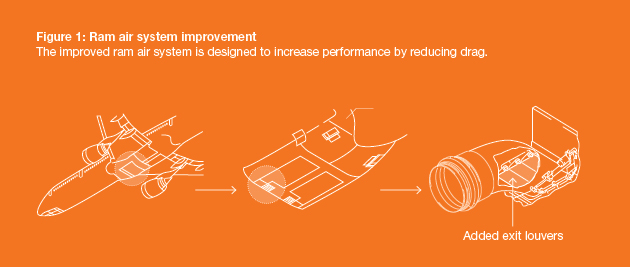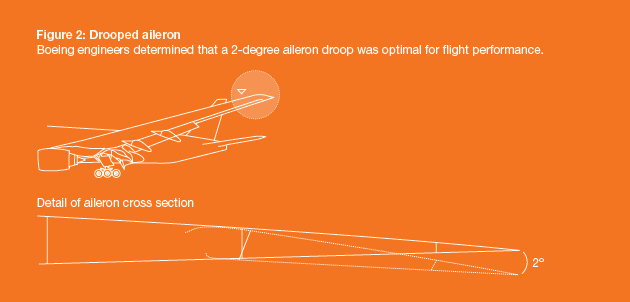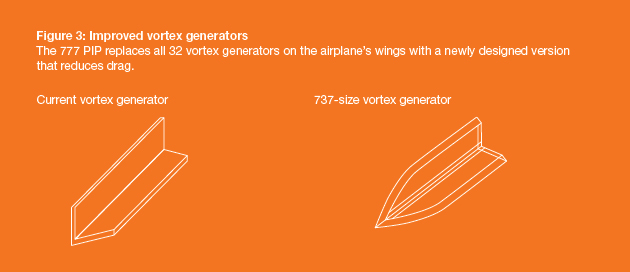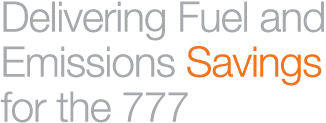
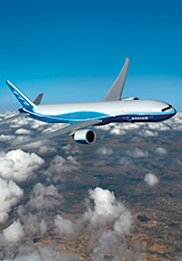
Boeing’s new 777 Performance Improvement Package (PIP) provides operators with a cost-effective way to retrofit their existing 777-200, 777-200 Extended Range (ER), and 777-300 airplanes in order to save fuel and reduce carbon dioxide (CO2) and nitrogen oxide (NOx) emissions. The 777 PIP provides a typical 777-200ER airplane with an annual savings of 1 million pounds of fuel and an annual reduction of CO2 emissions of more than 3 million pounds (1,360,800 kilograms). Operators can realize tremendous savings when multiplying these benefits across their 777 fleet.
By Ken Thomson, Project Manager, Modification Services,
Business Development & Strategy, Commercial Aviation Services; and
E. Terry Schulze, Manager, Aerodynamics
The 777 PIP package lowers operational costs and improves the environmental profile of existing, in-service airplanes.
When Boeing was designing the 777-300ER, several performance enhancements were made to extend the airplane’s range and payload capabilities. Boeing engineers realized that many of these enhancements could be retrofitted to earlier models of the 777 to improve their performance.
The result is the 777 PIP, which is available for 777-200, -200ER, and -300 airplanes. It reduces fuel consumption by 1 percent or more, depending on range, with corresponding reductions in CO2 and NOx emissions. Since Boeing made the PIP available in late 2008, kits for approximately 300 airplanes have been sold to 17 customers.
This article describes the elements comprising the 777 PIP, the performance improvements the PIP makes possible, and information for operators considering implementing the PIP.
COMPONENTS OF THE 777 PIP
The 777 PIP has three separate elements: an improved ram air system, aileron droop, and resized vortex generators.
Improved ram air system. The new exhaust housing has exit louvers that provide exhaust modulation to the environmental control system ram air system. The ram air flow through the system is controlled by using an optimized modulation schedule for the ram air inlet door and the exit louver positions. The improved system lowers airplane drag by improving thrust recovery at the exit of the system (see fig. 1)
[+] EnlargeDrooped aileron. This software-based modification reduces drag by creating higher aerodynamic loading on the outboard part of the wing and making the spanwise loading more elliptical. As the aileron droops, the increased loading also causes a wing twist change that reduces the local flow incidence toward the wingtip. This reduces the shock strength on the outboard wing, thereby reducing drag even further (see fig. 2).
[+] EnlargeResized vortex generators. Replacing the original 777 vortex generators with the smaller 737-type vortex generators reduces drag while maintaining the effectiveness of the original design (see fig. 3).
[+] EnlargeHOW THE 777 PIP IMPROVES PERFORMANCE
The 777 PIP makes possible three operational improvements to previously delivered 777 airplanes. These improvements are mutually exclusive — an operator can realize one effect per flight.
- For an operation carrying the same payload as a non-PIP airplane, the PIP-equipped airplane will fly farther.
- For an operation flying the same range as a non-PIP airplane, the PIP-equipped airplane will carry more payload.
- For an operation carrying the same payload and flying the same range as a non-PIP airplane, the PIP-equipped airplane will reduce fuel consumption as well as reducing CO2 and NOx emissions commensurately (see fig. 4).
Figure 4: 777-200/-200ER/-300 block fuel vs. range
Boeing typical mission rules with 2,000-ft cruise steps, 210-lb passenger allowance, and standard day temperatures.

OPERATOR INFORMATION
The 777 PIP comprises three separate service bulletins, one for each of the elements in the PIP. While maximum performance gains are realized by equipping an airplane with all three elements, operators may choose to implement them separately in a way that corresponds to their maintenance schedule.
The drooped aileron is a software modification that can be accomplished within three hours. The vortex generators can be replaced overnight. Because the ram air system involves modifications to the airplane’s environmental control system, it requires several days. As a result, operators may choose to perform this modification during a heavy maintenance check. The first two modifications alone will enable operators to realize about 60 percent of the total PIP benefit until the ram air modification can be scheduled.
In most cases, Boeing anticipates that operators should experience a 12- to 18-month payback period when implementing the full complement of PIP elements.
SUMMARY
Boeing is committed to improving existing, in-service airplanes. The 777 PIP package lowers operational costs and improves the environmental signature of the airplanes.
For more information, please contact Ken Thomson or Terry Schulze.


